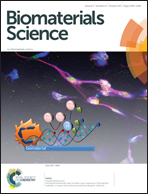Neutrophil extracellular trap formation upon exposure of hydrophobic materials to human whole blood causes thrombogenic reactions
Abstract
Neutrophil extracellular trap (NET) formation, a reaction of the innate immune system to fight pathogens, was shown to be involved in thrombus formation. In the present study blood-contacting biomaterials with graded surface characteristics were investigated as a potential cause of NET formation on medical devices. Surface properties are known to govern protein adsorption, cell adhesion and ultimately the activation of several other host defense pathways – potentially also the formation of NETs. Model materials of defined hydrophilic or hydrophobic properties (glass, and thin films of poly(ethylene-alt-maleic anhydride), self-assembled monolayers of methyl terminated alkanethiols, and Teflon AF™) were incubated either with isolated human granulocytes after pre-adsorption with plasma proteins or with human whole blood. NET formation – detected as extracellular DNA, citrullinated histones, elastase and reactive oxygen species (ROS) – was observed on hydrophobic surfaces. Furthermore, NET formation on the hydrophobic surface Teflon AF™ resulted in elevated thrombin generation in hirudin-anticoagulated whole blood, but not in heparinized whole blood. Disintegration of surface-bound NETs by DNase treatment resulted in significantly lower pro-coagulant effects. Thus, NET formation can contribute to the thrombogenicity of clinically applied hydrophobic materials, suggesting NETosis as well as NET surface anchorage as new targets of anticoagulation strategies.



 Please wait while we load your content...
Please wait while we load your content...